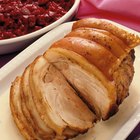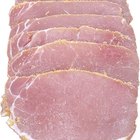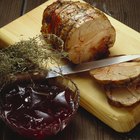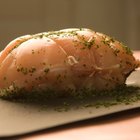Pork chops, those delicious cuts of meat beloved by children and adults alike, are cut crosswise from the long muscle known as the loin. The equivalent cut from cattle is called a steak rather than a chop, but each usually refers to a combination of the part of the animal and the direction that it's cut. If you buy fresh pork chops from the grocery store, it can be hard to know the best way to handle them. Since the pork was cut and packaged in another kitchen, you may have reservations about preparing it straight from the package, but understanding how to handle the fresh chops can provide peace of mind.
Proper Preparation
The bacteria that pork can carry is vulnerable under the proper cooking procedures. Any bacteria that may be found on the surface of the meat will not survive cooking. There is no need to wash pork before you cook it for fear of bacteria concerns. Keep your pork refrigerated at 40 degrees or below and avoid letting it sit at room temperature to reduce the risk of bacteria growth.
Cross-Contamination
If you have concerns about contamination from other things in your work area, rinsing the pork before you season and prepare it may give you peace of mind that nothing was left on the outside of the pork that may make you sick. If you follow proper handling procedures and avoid letting raw foods contaminate each other, there is no cause for concern.
Marinating and Brining
You can preseason and tenderize your chops by placing them in a bag with a dry rub of seasoning mix or even your favorite salad dressing mix. Alternatively you can brine chops in salted water or marinate them in creamy dressing. If you brine your pork chops, you should rinse them thoroughly before cooking to get rid of the excess salt from the outside of the meat. Avoid rinsing the meat if it was marinated if you want to preserve the marinade glaze on the outside of the pork. The glaze is particularly useful when you grill pork, because it caramelizes on the outside of the meat.
Safe Cooking
The USDA's recommended cooking temperature for pork is 145 degrees Fahrenheit. Despite the overwhelming fears that slight pink color means undercooked and unsafe pork, as of 2011, the USDA released a statement that pork is safe when cooked to 145 degrees, even despite mild pink coloring. Always test the temperature with a meat thermometer before removing it from the heat source.
Related Articles
Can I Eat Smoked Pork Chops Without ...

Can Pork Roast Be Pink in the Middle?

How Do I Tell If Pork Has Turned Bad?

Can I Eat Pork That Smells Bad if I ...

Can You Cook Pork Two Days After ...

Perfect Way to Cook a Pork Chop in the ...

How to Know When Pork Roast Goes Bad

Food Safety Tips for Frozen Pork
How Long Do Thawed Pork Chops Stay ...

How to Use Grill Mates Pork Rub
Can I Freeze Pork Immediately After ...

How Long Is Pork Good for While Frozen?

Cooking Instructions for Lamb Chops

How to Cook Deer Brats

How to Braise Pork

How to Tell If a Pork Roast is Done

How to Cook a Center Cut Pork Loin in a ...

What Are the Dangers of Raw Pork?
Can I Eat Smoked Pork Chops Without ...
How to Smoke Center Cut Pork
References
Writer Bio
Tara Kimball is a former accounting professional with more than 10 years of experience in corporate finance and small business accounting. She has also worked in desktop support and network management. Her articles have appeared in various online publications.